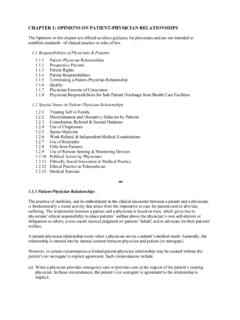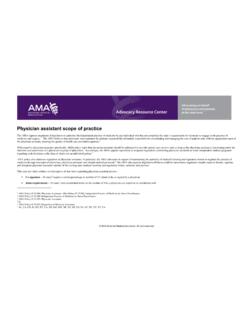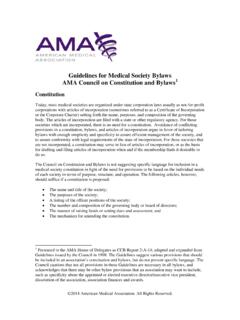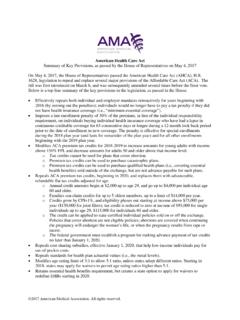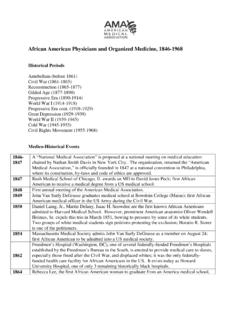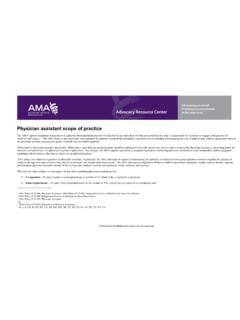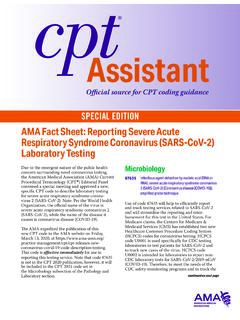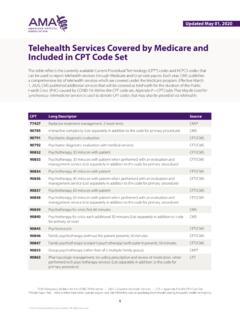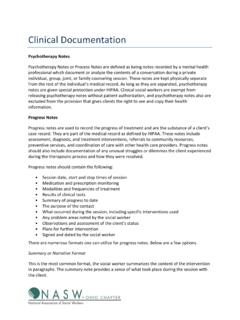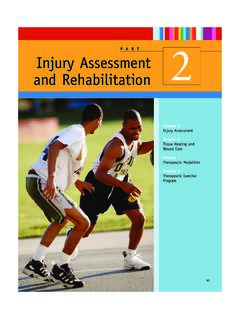Transcription of 2021 E/M Updates: What will happen to the Physician Note
1 How did we get here?Modern uniform billing requirements for Physician documentation of outpatient clinic visits came about in the mid-1990s. At the time, notes were generally handwritten with copious obscure abbreviations which were often meaningless to all but the author. Doctors included whatever information they thought was relevant, often focusing on what they needed to remember for the next visit or what they thought a colleague might need to know if covering on call. Sample notes :2021 E/M Updates: What Will happen tothe Physician 1995, and then again in 1997, CPT Evaluation and Management (E/M) documentation guidelines were put in place which strictly defined requirements for each code. Seven components were used to judge which code was appropriate for a given outpatient E/M service: fHistory fPhysical exam fMedical decision making (MDM) fCounseling fCoordination of care fNature of presenting problem fTimeBased on complicated rules strictly defining characteristics of the problem at hand, review of systems, physical exam, and MDM, the proper E/M code could be StateComplicated E/M requirements for documentation of clinic visits, combined with other factors such as increased litigiousness and development and growing ubiquity of electronic health records (EHRs) lead to progressively longer and more detailed notes (in other words, note bloat).
2 While ambulatory progress notes outside the United States averaged less than 2000 characters, documentation by American physicians average more than twice that number. At the same time, an epidemic of clinician burnout is occurring in the United While the cause of burnout among physicians is multi-factorial, the EHR is a contributor,2 and doctors spend a third of their time in the EHR documenting patient Groups such as the American Medical Association (AMA) and others identified the need to reduce the administrative burden associated with writing ambulatory notes , and a revision to the E/M guidelines was E/M Documentation RequirementsThe AMA worked toward four guiding principles when redesigning E/M rules: fDecrease administrative burden fRemove scoring by history and physical exam fCode the way physicians and other qualified healthcare professionals (QHP) think fDecrease the need for audits fMore detail in CPT codes to promote payer consistency if audits are performed and to promote coding consistency fDecrease unnecessary documentation that is not needed for patient care in the medical record fEliminate history and exam scoring fPromote high-level activities of MDM fEnsure that payment for E/M is resource-based and has no direct goal for payment redistribution between specialties fUse current MDM criteria (CMS and educational/audit tools to reduce the likelihood of change in patterns) E/M Updates.
3 What Will happen to the Physician NoteChanges to E/M Guidelines It s important to note that E/M changes apply only to outpatient office visits. Further, these changes do not go into effect until Jan. 1, new E/M level of service codes are based on either MDM or time, and do not take into account discrete documentation of the review of systems (ROS) or physical exam. Extensive clarifications and simplifications were provided in the guidelines to define the elements of MDM. With respect to time, the updated E/M codes include total time spent by the Physician on the date of the encounter (before the visit, face-to-face time, and time spent after the visit) and do not require that counseling makes up at least 50% of the time of the visit. Clear time ranges were defined for each is anticipated that most often, physicians will use the medical decision-making guidelines to calculate the appropriate E/M code.
4 Typically, time will be utilized for visits that were low acuity yet required significant Physician time for the following types of activities: fPreparing to see the patient ( , review of tests) fObtaining and/or reviewing separately-obtained history fPerforming a medically necessary appropriate examination and/or evaluation fCounseling and educating the patient/family/caregiver fOrdering medications, tests, or procedures fReferring and communicating with other health care professionals (when not reported separately) fDocumenting clinical information in the record fIndependently interpreting results (not reported separately) and communicating results to the patient/family/caregiver fCare coordination (not reported separately) What This Means for Healthcare Organizations Impacts: f With changing documentation requirements, clinicians will need to determine when to code using MDM vs.
5 Total time on the day of the encounter fPhysician and coder efficiency and productivity will be affected fLevel of service benchmarks might have to be adjusted fCompensation changes may be in the works based on the potential for higher acuity codes to be generatedRisks: fPhysicians may continue to document as they have for the last 25 years leading to unnecessary documentation and wasted time by physicians and coders fThere is the potential for increased coding errors and clinicians and coders adjust to the new guidelines fRisk adjustment reductions and revenue take backs might occur if acuity levels decrease significantlyOpportunities: fIncreased Physician satisfaction via more meaningful, streamlined documentation fImproved clinical workflows that allow the patient and care team to contribute directly to the documentation fPatient throughput may be streamlined given fewer requirements for clinically-unnecessary documentation fPhysicians may see increased reimbursement given the clarified documentation E/M Updates: What Will happen to the Physician NoteWhat Belongs in the Physician Note?
6 Doctors write notes to: fRemind us what we found, said, and did fCommunicate to other clinicians what we found, said, and did (aka continuity of care) fAllow us to get paid for services rendered fEngage patients in their care4 (a new reason related to the 21st Century Cures Act, but a great reason) fTo prove that we practiced quality care fTo help defend against a medical liability claimThe Physician need not be the only contributor to the clinic note. The patient and the clinic s support staff can start the progress note and add important information. The patient knows the history of present illness, any interval history if appropriate, and the medication they are taking. The clinic medical assistant or nurse can review the patient s history, record appropriate vital signs, and do any necessary screening.
7 Ultimately, the Physician reviews the information, documents appropriate elements like the physical exam, assessment, and plan, and signs the note. Reimagining the Ambulatory Physician Progress NoteKey components of a typical note, today vs. the E/M Updates: What Will happen to the Physician NoteToday fReason for visit fHistory of present illness fReview of symptoms fVital signs fPhysical exam fTest results (often via cut/paste) fAssessment and plan Future fHistory of present illness (with reason for visit and review of symptoms) fVital signs summarized fPhysical exam (as needed) fImportant test results noted and interpreted fDetailed assessment and plan including differential and workupAs we move to a less dogmatic system for assigning billing codes for outpatient documentation, physicians are free to incorporate clinical information in a way that makes the most sense to them.
8 There need not be a discrete section called reason for visit or chief complaint, but instead this sort of clinically-relevant data can be included in the history of present illness. Since physical exam is no longer a requisite part of the note for billing purposes, documentation of exam can be as comprehensive or focused as is called for by the patient s condition. 1. Remove unnecessary information and duplicationOne of the great things about the EHR is that it allows (and perhaps even encourages) clinicians to bring data into the ambulatory progress note. Gone are the days when physicians used abbreviated fishbone diagrams to recopy and summarize lab data in order to incorporate it into the progress note. Now with a few keystrokes, the entire list of lab results can be entered into the documentation, including much more than just the important should only include relevant information in their notes , incorporating specific results when appropriate or simply referencing them in summary form.
9 For example, instead of bringing in a plethora of unnecessary data points with a complete blood count result, simply noting that the CBC is significant for worsening thrombocytopenia will likely add more value to the note Embrace the encounter reportIn the pre-EHR days, the progress note was the end-all and be-all of the office visit documentation. If information wasn t included in the progress note, it didn t exist. This need not be the case using many modern EHRs. Today, many vendors have a concept of an encounter or visit report, which can be thought of as a grouping of building blocks, each of which brings in certain data points relevant to the visit. The encounter report can be stored statically when the Physician closes or signs off on the visit, thereby representing a holistic accounting of what happened.
10 In this case, the Physician s progress note becomes just one part (albeit the most important part) of the record of the Upend the soap note with the APSO formatWhile the workflow of an office visit will virtually always involve the same information-gathering techniques in the same order, the clinic progress note doesn t need to follow that same sequence. The typical clinic note follows the SOAP format : subjective, objective, assessment, and plan. Indeed, this is the order in which most office visits occur. The patient offers up a history of any health problems and might answer questions about signs or symptoms (subjective). The Physician performs a physical exam, reviews any lab or other results (objective), summarizes the findings (assessment), and the next steps (plan). Given the way most EHRs function, it can make sense to put the assessment and plan part of the note at the top (APSO).
